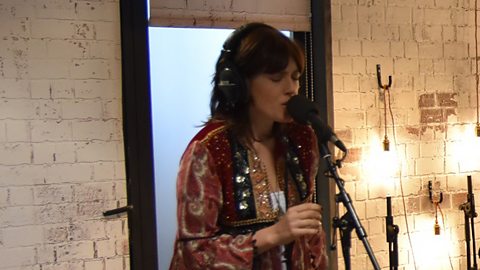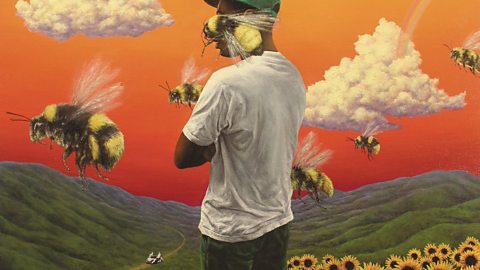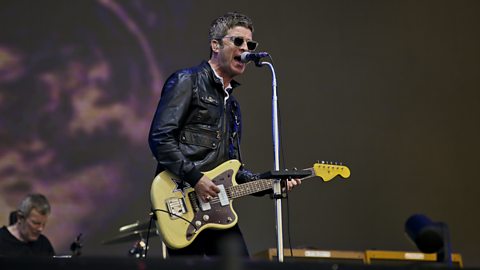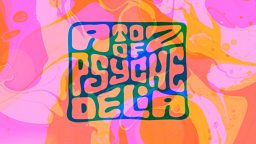How psychedelia inspired a new generation of artists
19 July 2018
6 Music is celebrating the world of psychedelia with the launch of its new A-Z of Psychedelia podcast.
If you’re new to psychedelic music, it’s the perfect introduction, featuring fascinating stories of a world-changing counter-culture, that still influences some of today’s best new music. While psychedelia is heavily associated with Jimi Hendrix, The Beatles, Pink Floyd and the late 60s, there are a wealth of artists proving its alive and well in the 21st century.
From Tame Impala and Noel Gallagher to Melody's Echo Chamber and Tyler, The Creator, via a brief flirtation from Arctic Monkeys, here are 12 acts who have taken inspiration from the genre and moved things forward in a very modern way - some of psychedelia’s most out-there current practitioners.
1. Tame Impala

Tame Impala - Radio 1’s Big Weekend 2016 Highlights
Highlights of Tame Impala's set at Radio 1's Big Weekend 2016
Kevin Parker’s one-man recording project turned many-limbed live psych beast is the rampaging figurehead of psychedelia’s resurgence in recent years. Their richly retro sound is characterised by classically psych effecs like fuzz, delay and reverb born of Parker’s obsession with audio experimentation. At the age of 11 or 12, Parker told Audio Technology magazine, he made his first "fantastical discovery”", recording himself playing keys over the top of a rudimentary drumbeat with two tape decks: "I couldn’t even play for s***. But it was amazing! There’s been no real structural change since then, I’ve just slowly gotten better at it."
The secret of Parker’s success is emulating the classic guitar and vocal effects of the psychedelic bands that captured him in his teens – Cream, Jefferson Airplane, The Beatles – but approaching them in an idiosyncratic, home-made way. Tame’s songs use plenty of delay, echo, compression, flange, unsuitable mics in strange positions and vintage synths. But where in the hands of many, such audio nerdery might lead to dry, studied music, in Parker’s hands it leads to the likes of the romping, mighty Elephant, a psych-rock classic of our times.
2. Melody's Echo Chamber
Warning: Third party content may contain adverts
The dreamy psych-pop solo project of Frenchwoman Melody Prochet, Melody’s Echo Chamber is another star of the psych constellation in the orbit of Kevin Parker. The Tame Impala frontman produced the outfit's eponymous debut album after Prochet’s former band My Bee’s Garden supported the Aussie group on tour.
"I tend to write songs with pretty chords and arpeggios, and I was kind of boring myself," she told Noisevox at the time. "So I asked Kevin to destroy everything." Parker’s production was more than matched by Prochet’s light, cool vocal presence and songs that drew on the electronic psych of Stereolab and Broadcast as well as French ye-ye pop. Her second album, Bon Voyage, was delayed by a near-fatal accident, but was released, with Prochet happily on the road to recovery, in June, featuring a more modern, sampledelic sound.
3. Arctic Monkeys

Arctic Monkeys - Glastonbury highlights
Highlights of the Arctic Monkeys' headline set on the Pyramid stage at Glastonbury 2013.
Sheffield grit-mongers Arctic Monkeys and their hair have been on quite an adventure over the past 12 years. It was in 2009, on Humbug, when things really started to get strange. In classic third album fashion, they were keen to show what they could do, who else they could be, and so decamped to Rancho de la Luna studios in Joshua Tree national park, southern California with Josh Homme of Queens of the Stone Age, the high priest of desert rock. A crossbreeding of metal, blues and psychedelic rock, desert rock is known for its long, grinding, hypnotic grooves and enthusiastic use of psychedelic substances, and had a marked influence on Alex Turner and the boys.
This is “the record where they get weird, grow up and trip out”, Homme told GQ. Alex Turner’s realist lyrics began to take a turn for the bizarre on the lateral, loping likes of Crying Lightning (“The next time that I caught my own reflection It was on its way to meet you”) and The Jeweller’s Hands (“You think excitement has receded then the mirror distracts/The logic of the trance quickly reaches and grasps”). Talking to NME before the album’s release, Turner and drummer Matt Helders tried to bend their minds round what you would see if you lined up a certain configuration of one-way and standard mirrors. “I can’t figure out what it would look like because no-one’s ever seen a mirror without a reflection in it,” mused Helders, prompting interviewer Hamish MacBain to ask: "Jesus, Joshua Tree and Josh Homme: just what the hell have you done to the Arctic Monkeys?”
4. Goat

True psychedelic disciples, Sweden’s Goat exemplify the shamanic trance power of the repetitive groove. They’re also a masterclass in the psychedelic power of myth and image-making. Led by the enigmatic, yarn-spinning Goatman, they claim that the band is thousands of years old, has 2,500 members and hails from remote Korpilombolo in the north of Sweden, a town they claim to be steeped in the practice of voodoo.
One thing that definitely isn’t apocryphal, though, is the power of the masked Swedes’ live shows, where their combination of psych, psych-funk, drone and wild heavy rock comes alive in a communal, cathartic ritual experience worth sacrificing a lot to experience.
5. Gwenno

Gwenno talks about her Cornish heritage, and how it has inspired her new album 'Le Kov'
Gwenno speaks to Lauren about the Cornish language, and how it has inspired her work.
Wales, home of the great Celtic myths of the Mabinogion, has a proud psychedelic history, from “Welsh Dylan” Meic Stevens via psych-prog titans Man to Gorky’s Zygotic Mynci and Super Furry Animals. Today the heritage is kept up by the likes of Cate Le Bon, H Hawkline and Sweet Baboo. Formerly of whipsmart girl-group The Pipettes, Gwenno Saunders goes one better, singing psych not just in Welsh but in Cornish – her father is a Cornish poet and linguist, her mother a Welsh translator who sings in a Welsh choir.
Her 2015 Welsh-language album Y Dydd Olaf won the Welsh music prize and Best Welsh Album at the Eisteddfod that year, while Le Kov, this year’s Cornish-language effort (including Eus Keus? “a war cry about cheese”), saw her hailed as “a high-priestess of 21st-century psychedelia” by The Quietus.
6. Tyler, the Creator

Tyler, The Creator has been dropping new tracks all week - this is Annie Mac's favourite.
Tyler, The Creator - GELATO is Annie Mac's Hottest Record for Thursday 28th June.
Some of the most interesting hip-hop of recent years, from Shabazz Palaces to Chance the Rapper, draws on a long history of psychedelic weirdness. Classic 60s psych rock filtered its way through funk with Sly and the Family Stone and Parliament-Funkadelic, a heritage revived by the supreme weirdness of Outkast and The Neptunes around the turn of the millennium. The mind-warping strangeness, and the sound in particular of the latter, was inherited by west coast collective Odd Future, founded in 2007, and their enigmatic, charismatic leader Tyler, the Creator.
As well as all the surreal horror and jazzy chords, Tyler’s inner journey is psychedelic in itself. Last year’s Flower Boy followed the heavily NERD-indebted Cherry Bomb, which saw a guest appearance from Pharrell. He also crossed psychedelic paths with Parliament-Funkadelic bassist Bootsy Collins on Kali Uchis’s After the Storm.
7. Tunng

Tunng - Flatland live in session
Folktronica pioneers Tunng perform Flatland live in session for Marc Riley
Until Australia revived classic psych rock and R&B got weird again, the most psychedelic genre around after the turn of the millennum was folk. Londoners Tunng, led by Sam Genders and former thrash metal guitarist and adult film soundtracker Mike Lindsay, were ahead of the wave of psychedelic folkies, and were more inventive than most, adding sampledelic beats and weird instruments to their English oddity and updated murder ballads.
Second album Comments from the Inner Chorus deployed teeth, twigs and shells, while song Arms from their 2007 album Good Arrows featured beats crafted out of the crackling of a bonfire. Their last album, 2013’s Turbines, was set in an eerily dysfunctional fictional village, while follow up Songs You Make at Night, reuniting their original lineup, will be out in August. Until then you can content yourself with the lightly spooky groove of single ABOP, released in May, and LUMP, Lindsay’s groovy, weird, droning side-project with Laura Marling.
8. Noel Gallagher

Noel Gallagher
Noel brought all the swagger and attitude to Perth.
Oasis’s untamed energy was always driven by the pull between classic Beatles psychedelic tendences and punk-meets-glam stomping riffery to match Liam’s Lydon-esque snarl. Since the brothers Gallagher parted ways in 2009, Noel has had free rein to indulge his psychedelic side. Even before the split he was already flirting with it in the guise of The Future Sound of London’s DJing side-project Amorphous Androgynous, who made the 22-minute A Monstrous Psychedelic Bubble Exploding In Your Mind remix of Oasis’s Falling Down.
It was announced that Amorphous Androgynous and Gallagher would release an album together, and though that never came to be, Gallagher’s subsequent work with High Flying Birds, particularly their 2017 David Holmes-produced album Who Built the Moon?, has been informed by a very similar late-90s-style mix of electronics and psychedelia. And then, of course, there’s the cape-wearing French scissor-player...
9. King Gizzard and the Lizard Wizard

King Gizzard And The Lizard Wizard
Highlights of King Gizzard And The Lizard Wizard's set at Glastonbury 2017
Well, they were never going to be mods with a name like that, were they? Taking their ludicrous moniker partly from Jim Morrison’s nickname The Lizard King, Melbourne’s fuzzy psych-garage space jammers King Gizzard have never let the side down when it comes to psychedelic album titles: I’m in Your Mind Fuzz, Nonagon Infinity, Flying Microtonal Banana. And like Tame Impala associates Pond or California’s The Oh Sees, they’ve also adopted a 60s-style, fast’n’prolific approach to recording, releasing five albums in 2017.They even have their own Melbourne festival for like-minded fellow musical travellers, Gizzfest.
But though frontman Stu Mackenzie cut his teeth on classic psychedelic garage band compilations Pebbles and Nuggets, and later world psychedelia like Turkey’s Erkin Koray or Japan’s Flower Travellin’ Band, he’s not sure the psych label fits the breadth of what they do. “What is psych?” he asked the Guardian. “If it’s an exploratory approach to music then perhaps we are. If it’s about creating huge walls of glistening, phased-out guitars then we are not. I’ve always felt more like a garage band than anything. We don’t write songs about space, either.” Ah, but what’s more psychedelic than refusing limits to your imagination? Gotcha.
10. Jane Weaver

Jane Weaver - The Architect
Jane Weaver performs live on The Quay Sessions
Formerly of teen Britpop band Kill Laura and folktronica group Misty Dixon, Widnes singer-songwriter Jane Weaver’s solo records exemplify the best of the British psych folk revival, combining respect for tradition with electronic innovation, hitting a peak on 2014’s The Silver Globe and 2017’s Modern Kosmology, which blended krautrock electronics, folk atmospherics and crate-digger retro references. Weaver also nourishes other artists with her Bird record label, an offshoot of psychedelic treasure hunters Finders Keepers that saw early releases by Beth Jeans Houghton and Cate Le Bon, as well as the compilation album Bearded Ladies, which put together female psychedelic folk acts old and new.
She’ll be taking a special live show of Silver Globe and Modern Kosmology songs on the road this autumn in a series called Loops in the Secret Society, featuring "custom-built vinyl discs... tape loops and zoetropic imagery", and possibly, she hinted to The Quietus, seances.
11. Thundercat

Thundercat
Highlights of Thundercat's set at Glastonbury 2017
Jazz did not escape psychedelia’s tendency to spike the waters of other genres, and the free experimentation of both genres made them a perfect pair. Before going solo, bass maestro Stephen Bruner, aka Thundercat, played on neo-soul and alternative hip-hop records steeped in the history of acid jazz and psychedelic funk such as Erykah Badu’s New Amerykah and Flying Lotus’s Cosmogramma. His own wildy inventive albums, and his work on Kendrick Lamar’s To Pimp a Butterfly, are influenced by psych-funk and 70s jazz fusion.
In 2017, he told NME that when he was playing in Snoop Dogg’s band back in the early 2000s, he introduced Snoop to Billy Cobham and Frank Zappa. "He’d not really heard them before and [had a] really perplexed look on this face like, ‘what is this?’ I told him and Snoop just cartwheeled down the hotel hallway, trippin’ out to jazz fusion. I’ll never forget it.”
On the darker side of mind-blowing, Thundercat’s second album Apocalypse and the EP The Beyond/Where the Giants Roam explored death and the afterlife, while last year’s Drunk took you into a snapshot of Thundercat’s weird and wonderful day-to-day world, with guest spots from Pharrell, Kamasi Washington and Kenny Loggins.
12. The Internet

A spin-off band from Odd Future, Syd tha Kyd and Matt Martians’s side-project The Internet has become its own creative entity over the course of three acclaimed albums since 2011. Syd’s delicate voice took centre amid a proggy, psychedelic jazzines on their neo-soulful, trip-hoppy debut Purple Naked Ladies and its follow-up Feel Good. The extremely psychedelically titled Ego Death, released in 2015, took things in an even trippier direction with the likes of Gabby, featuring fellow psychonaut Janelle Monáe, a low-down and funky slice of relationship woe featuring a deeply trippy jazz-funk breakdown.
“With my writing I got a little more vulnerable with this album, and I think I also got more confident,” Syd told Nylon. “It’s interesting because it’s both sides of the ego: It’s the arrogant, ‘I know I’m the s***’ side of me, but it’s also like, damn, I still got problems.”
Listen to 6 Music's A-Z Of Psychedelia podcast

Want to learn more about the evolution of psychedelic music? 6 Music's new A-Z Of Psychedelia podcast offers a definitive look at the genre at its Sixties peak, featuring psych icons such as Hendrix and Pink Floyd whilst also celebrating lesser-known artists like Linda Perhacs.
Presented by 6 Music's Marc Riley and music journalist Rob Hughes, the 36-episode series tells the complete story of the world-changing counter culture, featuring some amazing stories, like George Clinton's hair-straightening job, The Beatles' chauffeur contributing backing vocals and what Brian Wilson and his brothers did when their mum and dad went on holiday.
Follow us on Facebook, on Twitter @BBC6Music, or on Instagram @BBC6Music.
More Psychedelia on 6 Music
What is psychedelia?
Though the second word to spring into mind your mind after “psychedelic” is probably “60s”, the word actually predates the swinging decade. It was in fact coined, from the Greek for “soul-revealing,” in 1956 by psychiatrist Humphrey Osmond, who, along with his acquaintance Aldous Huxley, was trying to find a way to describe the mental experiences produced by LSD, which he had been researching in connection with schizophrenia. (Huxley’s less phonetically pleasing suggestion, “phanerothyme”, thankfully didn’t make the cut.)
Psychedelia in rock and folk started to emerge in the early 60s on the west coast of the US, with The Holy Modal Rounders, 13th Floor Elevators and Deep among the first acts to use the term. Music that distorted time and space through grooves, drones, exotic instruments and effects such as delay, wah and reverb went on to be popularised by bigger acts including The Beatles and Hendrix.
The first psychedelic era peaked with the Monterey Pop Festival and Woodstock, but psych in music proved surprisingly resilient, re-emerging again and again – and we’re currently in the middle of a particularly rich vein of weirdness. Perhaps psychedelia is just a natural expression of human optimism, of reaching for something outside ourselves. Or maybe it just sounds really cool.











